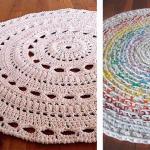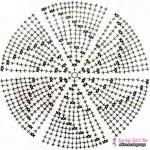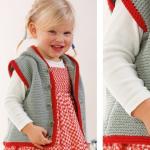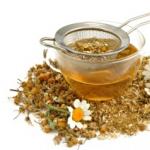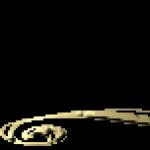Felt toys. Schemes and patterns of felt toys for beginners
It's nice to do something useful on a Saturday evening.
It’s doubly interesting to make some cute DIY crafts with your baby.
Today's master class is dedicated to making textile fish.
They are all small in size and different colors.
This can be used and built in parallel decorative panel in a nautical style, which in the best possible way would look great next to a baby's crib.
More future fish can be hung from the ceiling by strings. The result will be a wonderful floating composition. Such a creative work will elegantly decorate the interior of a children's room or bathroom.


Stage No. 1
Rainbow fabric fish
During the sewing process you will need the following materials: scraps of medium or high density fabric, non-stretchy, synthetic filling for the toy, several multi-colored pieces of felt, several buttons for the eyes. And also: sewing machine, matching threads, needle, scissors.

Pattern provided. It can be copied directly from the screen by hand or printed on a printer. Before printing, you can change the size to your desired size: reduce or enlarge the layout. As you can see in the figure, allowances have already been taken into account. The numbers also indicate the number of parts to be cut.

After printing, all the details of the fish are cut out and applied to the fabric. At this stage of work, it is advisable to carefully consider the color scheme of the toy. Fabrics should match in color and not cause visual rejection. It may be worth choosing colors for a specific interior. Such a craft can become the highlight of the room, a bright accent.
Once the pattern pieces are ready, you can cut them onto the fabric. It is advisable to outline the contours with soft tailor's chalk or a disappearing marker. IN as a last resort, pencil or pen.

The felt heart is sewn on first. The part is simply cut out in the shape of a heart with scissors. There is no need to process the edges, since the felt does not fray around the edges. The shape is sewn in the tail area using a sewing machine. A special “line 1 millimeter from the edge” is laid. For such stitches, the sewing machine has a foot that adjusts the width of the indentation.
Next, multi-colored scales are made. Each scale is stitched along the edge from the wrong side, and then turned onto the face. A small amount of synthetic filler is stuffed into all five flakes. They need to be given a little volume. Next, they are pinned with needles to the product in the torso area.


The remaining three scales are sewn using the same pattern.

The result is a fish that does not yet have fins.
To make the fins, 4 pieces of fabric are cut out, two of which are mirrored. On the wrong side, future fins are stitched along the edge, turned right side out, stuffed lightly with synthetic filler and sewn to the main part.

The second half of the fish can be made in two versions. In the first case, a mirror image of the first half is made. Everything follows the same scheme as described above. In the second case, fabric is simply sewn to the second half. No decorations. This option is suitable for vertical panels. Let's look at it below.
The finished half of the fish is laid out on the table with the wrong side up. Attention, the fabric under the fish is wrong side down.

In order to lay the stitch evenly, the fabric and the fish are pierced with tailor's needles. Only the tail will remain unstitched so that you can later turn the fish right side out. Next, a machine is used to lay a line “0.5 cm from the edge” along the contour. All excess is cut off with scissors.
In order for the fish to have a beautiful oval shape After turning, in places where the curves are rounded on the wrong side, notches are made with scissors. After which the product is turned inside out and checked to see if the seams are stretching anywhere. Otherwise, the number of notches increases.
Now the fish can be stuffed with synthetic filler. Next the tail is sewn up. The sections on both sides are folded 0.5 cm inward and sewn with a blind stitch manually.
The eyes are sewn on.
Stage No. 2
Miniature felt fish
This creative process characterized by simplicity. The pattern is printed and the parts are cut out from felt. The size of the fish can be adjusted before printing on the computer.

From orange felt you will get clown fish with white wavy stripes on the sides. Made from yellow felt - butterfly fish with red spots on each side. And the fish with black stripes is the oceanic striped brahma. For a variety of marine flora, you can cut out a couple of jellyfish.

These toys are sewn on the front side, since with such miniature size, turning the products inside out is impossible. Folds can damage or render unusable the material itself - felt.
In order to entertain your baby even more, you can sew magnets into the fish and make not a floating mobile, but a toy for the refrigerator. However, if handled carelessly, such fish can easily be spoiled. The felt is torn.
You can play an interesting fairy-tale performance on magnetic boards. This activity will certainly please your child.
Large and small, bright and inconspicuous, the inhabitants of the ocean amaze with their variety of colors and shapes. That's why children like picturesque cartoons about wonderful sea creatures so much. Do you want the characters from the cartoon “Finding Nemo” to come to your home? Rather, make them from felt.
You will need:
- multi-colored felt,
- threads,
- magnets,
- scissors,
- needle,
- filler,
- beads, sequins (optional).
Clown fish pattern- the first on our list of inhabitants of the sea kingdom. Making the mischievous Nemo and his dad will not be difficult.
Sew white wavy stripes to the orange blanks. Make eyes out of black beads. Sew the halves of the fish, filling the toy with cotton wool or holofiber.

Sea stars- universal felt crafts. They can decorate the entire room, turning it into either a fabulous seabed or a starry sky. What will your imagination draw today?

Felt jellyfish. Creating a toy will not take even 20 minutes. Simply sew together parts of the jellyfish, inserting felt tentacles between them. All! Medusa is ready.

Angelfish, probably one of the most beautiful sea creatures. Shall we make it?

Now I'll show you how to do it parrot fish with your own hands.

What else can you make from felt? Whatever! For example, lemon butterfly.

Anemones- a wonderful decoration for your aquarium.

Butterfly fish Sewing from felt is also very easy. Just don’t forget to decorate the fish with sequins and sew on beads for eyes.

And finally - a little scenery. Colorful corals will perfectly complement your aquarium.

Just a small matter: use superglue to attach a small magnet to the back of the toys. An excellent magnetic aquarium is ready! But if you are delighted with voluminous soft toys, just make larger patterns, and you will get a whole collection of sea creatures, which, by the way, can also be used as small pillows.

You can make a real picture out of these beautiful fish using beads, sequins and artificial stones.

Colorful fish will become a great gift a friend or one of your relatives.

Happy creativity!
Fish made from napkins and ribbons. Master class on making a souvenir.
Victoria Anatolyevna Zolotaya, teacher additional education MBU DO SUT No. 2, Taganrog Rostov region.Target: teach how to make a souvenir in the shape of a fish.
Tasks:
- develop fine motor skills, Creative skills students,
- bring up artistic taste, neatness.
Purpose: interior decoration, gift for family and friends.
Master Class intended for students over 6 years old, for their parents, as well as for additional education teachers.
Materials:
universal viscose napkin (felt),
ribbons,
cardboard,
universal glue,
skewer,
fish eyes,
sequins.
Progress.
Draw the body of a fish on cardboard and cut it out.
Prepare a universal napkin, trace and cut out two parts of the fish’s body on it.

For the upper fin, cut 5 strips of 4 cm each from the ribbon. Glue them together with loops.


For the lower fins, cut two strips of 5 cm each. For the tail, cut two strips of 11-13 cm each. For the mouth, cut 2 strips of 3 cm each from the red ribbon. Glue all the strips together with loops.
Glue all the fins, tail and mouth on the cardboard side. Attach the skewer.

Glue the second part (from a napkin) of the fish’s body. Attach eyes on both sides. Glue the sequin flakes.
The fish is ready!
Fantasy textile fish and their practical applications
Chukreeva Alevtina Nikolaevna, technology teacher, additional education teacher at MAOU Gymnasium No. 202 “Mentality”, Yekaterinburg.
Description of material: This master class presents two methods of making fancy fish from textiles. Bright textile fish can be made from leftover fabric that can be found in any home; you can make them fancy if you offer different shapes, materials and interesting ways decoration. Fishes are fast, playful and fun! Also suggested different variants such products and their practical use as decorative elements of the interior. We make such fish from younger schoolchildren and students of grades 5-6 in additional classes of the fashion theater “Kolorit”.
Purpose: This material may be useful in the work of educators, teachers of primary and secondary schools, as in educational activities, and for interior design of the group, game room, and will also be useful to parents for their child’s leisure activities.
Age of participants: This type of fish can be made by junior and intermediate students.
Target: making a fish from textiles and presenting options for its practical use.
Tasks:
- introduce the technology of making fish from textiles and show options for use in the interior;
- improve the ability to decorate a product in accordance with the theme;
- develop creativity, sense of style, compositional skills, fantasy and imagination;
- cultivate perseverance, accuracy, hard work.
Materials:
- bright scraps of fabric that match marine theme, it is better to use thick cotton fabrics;
- padding polyester or holofiber for filling;
- materials for decoration: braid, cords, sequins, beads, beads;
- 2 large buttons and 2 small ones for the eyes.


Tools, fixtures and equipment:
- hand needle No. 3;
- tailor's pins;
- threads in the color of fabric No. 60;
- scissors;
- remnants or tailor's chalk;
- a peg for turning out or a stick for sushi;
- sewing machine;
- iron.

In my master class I will show two ways to make textile fish. The first method is more complex, since a figured seam is made to connect the parts of the fish (tail and head), and the second method uses a straight seam, it is easier to manufacture and can be used by less experienced performers.
Method 1. Making a textile fish with a figured seam connecting the parts (tail and head).

The proposed pattern is made in full size with seam allowances, indicating the thread length and the number of parts. The pattern can be printed on a printer, the layout can be reduced or enlarged in advance.

After printing the pattern, we cut it out.


We prepare the fabric by ironing it on both sides. At this stage of work, it is advisable to carefully consider the compositional solution and color combinations in the product: the fabrics should be compatible in color and not cause visual rejection; you can choose colors for a specific interior. When selecting color combinations for a product, my children and I use the Oswald Color Wheel computer program, which can be downloaded from the Internet.

First, we connect the parts of the tail and body along a concave contour.
To do this, fold the fabric with the right sides inward and attach the patterns to the fabric with tailor's pins to avoid shifting. We outline the contours with soap or tailor's chalk; on light details, in extreme cases, you can use a pencil (make sure that there are no pencil lines left on the front side). Make sure that the details of the fish are cut out:
- along the grain thread indicated on the pattern;
- with the front sides facing inward, otherwise you will end up with pieces “for one hand”.

We cut out the blanks (you should get 4 parts), you can use zigzag scissors (there is no need to leave seam allowances, they are included in the pattern).


We fold the cut out parts of the head and tail with the right sides inward, align the cuts, pin them together, and mark control marks on one part—the place for turning them inside out.


On sewing machine We set the stitch length regulator to 1.5-2mm. The smaller the stitch, the neater the contour of the fish will look on the bends. At the beginning and at the end of the stitch we make 1 cm long bartacks.
On one part we sew the seam completely along the connection line, on the second - up to the control marks, leaving room for turning the workpiece inside out. It is better to leave the place for turning inside the straight section of the seam to make it easier to sew it up hand stitches.

Iron the seams towards the tail of the fish.

We chop off the resulting 2 parts with the right sides inward, grind along the contour, the seam width is 3-4mm.


We make small cuts at the bends, not reaching the 1mm line, then when turning, there will be no creases in the fabric in these places. We iron the blanks.

Turn the pieces inside out and straighten the seams from the inside with a peg or sushi stick. In the areas where the fish’s nose is everted and on the caudal fins, we use a needle, carefully use the needle to pry the tip that is not completely turned out and pull it out little by little. Be careful not to pull the threads out of the fabric.


Iron the inverted workpiece, straightening all the seams. We stuff it with holofiber or padding polyester. To stuff it with padding polyester, first tear it into small pieces. Using a peg or sushi stick, we stuff it tightly, first along the edge of the fish, and then stuff it into the body.


We combine the edges of the unsewn area on the abdomen and pin it together. We sew by hand with a hidden seam, inserting the needle exactly into the pressed folds.


We mark the place for the eyes (the diameter of the large button is 20 mm, the small one for the pupil is 10-15 mm). We sew on the buttons: we stick the needle in and out on one side of the fish, connect two buttons along the holes for sewing, string both buttons, insert the needle into the second button hole and pierce the fish all the way through. We take the needle out from the other side and string two more buttons onto it. We repeat this 3-4 times to consolidate.


We sew four buttons at once, slightly tightening the thread, the eyes are obtained in the recesses (eye sockets).

Fish do not have eyelashes, but we have a fancy fish and we can invent eyelashes for it, for example, from genuine leather black color, the image will be flirty and kind. Eyelashes can also be made from sequins or yarn. We embroider the mouth and nose using hand stitches or machine stitching.


Let's start creating the image of a fish, for this we will use various ways decoration:
- sequins to imitate scales;

- bindweed braid or any other decorative braid to cover the seam connecting the parts;

- finishing fabric with lurex to make a goldfish.

- a round cord along the contour of the fish to make it look elegant;

Method 2. Making a textile fish with a straight seam connecting the parts (tail and body).

Let's add a little variety and make multi-colored fish with a straight seam. This method is easier to manufacture, since the parts are connected in a straight line. On the pattern, the seam connecting the parts is straight.

To do this, at the initial stage we sew together several fabrics from which the fish will be made. The head may be golden and the tail dark red. We sew the gold stripe for the head and the dark red stripe for the tail together.



We bend the resulting cut in half, apply the pattern so that the seam on the pattern aligns with the seam on the completed part (we do not cut the pattern).

And further according to the above algorithm:
transfer the pattern to the fabric;

sew, cut;

turn it inside out, stuff it, sew on the eyes;




we decorate, we get this “Goldfish”.

We use textile fish as decorative elements in the students’ playroom primary school our gymnasium. To do this, we design and manufacture removable interior elements in a marine style, with which you can easily change it. The popularity of the marine style in the interior is explained by its lightness, unobtrusiveness, and special pleasant associations with summer and the sea. It is beautiful, stylish, original, festive and, most importantly, there will always be a good mood in such a room!
1. Attach the prepared fish to linen cords, crocheted and hang it from the ceiling, you get a wonderful floating composition in the form of a curtain or panel. We knit linen cords (11 pieces) 2.5 meters long from linen twine and attach decorative rings to them, which form an arch in the composition. We also attach elements of marine paraphernalia to the cords: shells, sea stars, anchor, it turned out to be the panel “Underwater World”.
Quote from message TATIC_222Textile fish. Pattern and master class
Cute checkered fish. And if you sew it from brocade, you will get a goldfish.
2.
3.
4.
5.
6.
7.




Pattern of a fish - carp. How to sew a goldfish
Quote from Irina_kondik's message Read in full In your quotation book or community!Pattern of a fish - carp. How to sew a goldfish
Carp is a very resilient fish that can live not only in clean fresh water, but also in ponds and swampy areas. River carp are able to overcome enormous distances and enormous obstacles on the way to their spawning site. His goal is life. Therefore, carp is a symbol of perseverance, endurance, determination, perseverance, and the image of a carp helps to fulfill desires, achieve success, and never give up. We suggest you sew a carp with your own hands using the pattern below.


Pattern of a carp fish toy:


Textile fish. Pattern and master class
Quote from message TATIC_222 Read in full In your quotation book or community!FISH
Cute checkered fish. And if you sew it from brocade, you will get a goldfish.
2.
3.
4.
5.
6.
7.
Series of messages "Toys with patterns.": Toys with patterns.
Part 1 - Cat in clothes
Part 2 - Cat and mouse.
...
Part 98 - Hedgehog
Part 99 - Hippopotamus has no waist...?!)))
Part 100 - Primitive frogs. Pattern
Series of messages "Textiles and primitives":
Part 1 - Miniature bunny. Pattern
Part 2 - Funny primitive bunnies
...
Part 63 - Bees!
Part 64 - My works. Coffee bunnies
Part 65 - Textile fish. Pattern and master class
Pattern of a fish - carp. How to sew a goldfish
Quote from Irina_kondik's message Read in full In your quotation book or community!Pattern of a fish - carp. How to sew a goldfish
Carp is a very resilient fish that can live not only in clean fresh water, but also in ponds and swampy areas. River carp are able to overcome enormous distances and enormous obstacles on the way to their spawning site. His goal is life. Therefore, carp is a symbol of perseverance, endurance, determination, perseverance, and the image of a carp helps to fulfill desires, achieve success, and never give up. We suggest you sew a carp with your own hands using the pattern below.


Pattern of a carp fish toy:


Pattern of a fish - carp. How to sew a goldfish
Quote from Irina_kondik's message Read in full In your quotation book or community!Pattern of a fish - carp. How to sew a goldfish
Carp is a very resilient fish that can live not only in clean fresh water, but also in ponds and swampy areas. River carp are able to overcome enormous distances and enormous obstacles on the way to their spawning site. His goal is life. Therefore, carp is a symbol of perseverance, endurance, determination, perseverance, and the image of a carp helps to fulfill desires, achieve success, and never give up. We suggest you sew a carp with your own hands using the pattern below.


Pattern of a carp fish toy:



